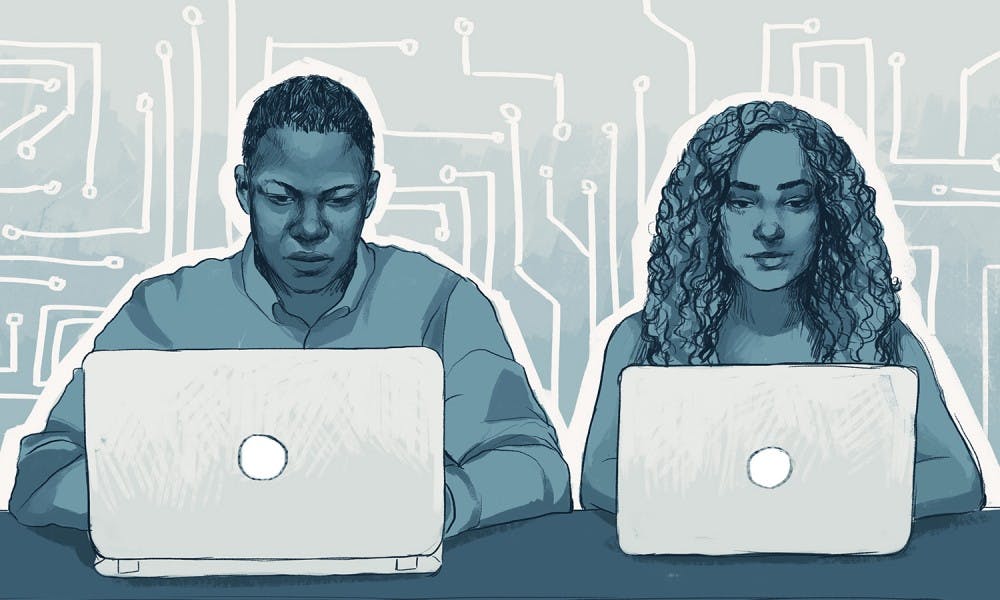Various reports this past summer have shown that virtually all major tech companies from Google to Facebook struggle with diversity. Penn, which has one of the top Engineering schools in the country, is no exception.
According to Penn's diversity statistics, 7 percent of Penn undergraduates are black, and slightly over 10 percent are Hispanic. These numbers are even lower in the Engineering school. Associate Director of the Office of Diversity and Inclusion Yulanda Essoka said the office receives an estimate of the number of students who self-identify as an underrepresented minority every year. The most recent numbers indicate that, of the total 800 Engineering students majoring in computer science at Penn, only 46, which is less than 6 percent, self-identified as an underrepresented minority.
Computer and Information Science Department Chair Sampath Kannan said the estimated figures for the graduating class of 2017 in Engineering are 5.4 percent for African-American students and 4.3 percent for Hispanics, but added that it's difficult to determine the exact number of underrepresented students because of the small sample size.
Kannan also said there is still work to do in "attracting African-American and Hispanic students to our major in numbers similar to Penn’s overall numbers.”

College Junior Brandon Obas, who is double majoring in computer science and cognitive science, said he believes that one way Penn can make it better for students of color is by hiring more diverse faculty within the Computer Science department.
“If I saw an African-American man teaching me computer science, I would be really inspired and more comfortable seeing someone who looks like me teaching a subject I’m so interested in,” Obas said.
In 2011, Penn launched the "Action Plan for Faculty Diversity and Excellence" to increase the percentage of underrepresented communities among the faculty, but six years later, data on the project showed mixed results. As of fall 2016, only 8 percent of the faculty in the Engineering school were underrepresented, a category that includes Hispanic/Latino, African American/Black and Native American/Alaskan Native people.
That being said, professors and students in the Computer and Information Science department have noticed an increase in students of color in the department over the years.
“If you looked back 10 years ago, I don’t think you would see nearly as many black or Latino people in the class," said Steve Zdancewic, a computer science professor who has taught the introductory computer science class CIS 120 several times.
CIS professor Chris Callison-Burch echoed this sentiment, noting that “it seems like there are more people of color this time around [in this iteration of CIS 121].”
Enrique Mitchell, a senior in computer science who has been a teaching assistant for CIS 120, said he’s also seen a jump in the number of black and Latino students who come to his office hours.
“When I was a freshman, we were definitely few and far between,” Mitchell said. “These last two semesters, I’ve definitely seen a jump in the number of black and Latino students [in CIS 120].”
Mitchell also noted the growth of resources in National Society of Black Engineers for students of color.
“When I first started there wasn’t a lot of support being black in computer science,” Mitchell said. “There were very few upperclassmen who could help me decide whether I wanted to study computer science.”
Penn also seems to have been more successful in recruiting women — also an underrepresented minority in Engineering departments — than it has in recruiting students of color.
Women make up 33 percent of Penn Engineering, which is higher than the national average of 18-20 percent in Engineering departments nationwide. In contrast, less than 10 percent of the Engineering school consist of black and Hispanic students, which is lower than the national average of 21 percent.
Engineering sophomore Ciara Brown said seeing a black person in her CIS lectures now still feels more like a novelty than reality.
“It feels like there’s not an emphasis placed by the university on diversity in STEM,” said Brown. “Those numbers across campus are fairly good but then you take a microscope to the Engineering school specifically, and the proportions are extremely different.”



